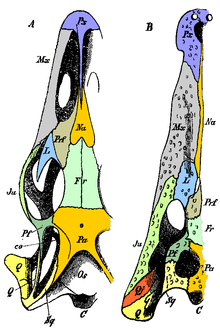Jugal bone

The jugal is a skull bone found in most reptiles, amphibians and birds. In mammals, the jugal is often called the malar or Zygomatic. It is connected to the quadratojugal and maxilla, as well as other bones, which may vary by species.
In dinosaurs
This bone is considered key in the determination of general traits of the skull, in the case of creatures, as with dinosaurs in paleontology, whose entire skull has not been found. The jugal bone forms the cheek area in dinosaurs, and is part of the series of bones termed the circumorbital series, as they define the margins of the orbit. Additionally, in some dinosaur genera the jugal also forms part of the lower margin of either the antorbital fenestra or the infratemporal fenestra, or both. Most commonly, this bone articulates with the quadratojugal, the postorbital, the lacrimal, and the maxilla.[1] The boundaries where some of these bones meet with the others are called sutures. In horned dinosaurs, like Pentaceratops, the jugal bone is thick and comes to a point, which has led paleontologists to refer to it as the "jugal horn".[2]